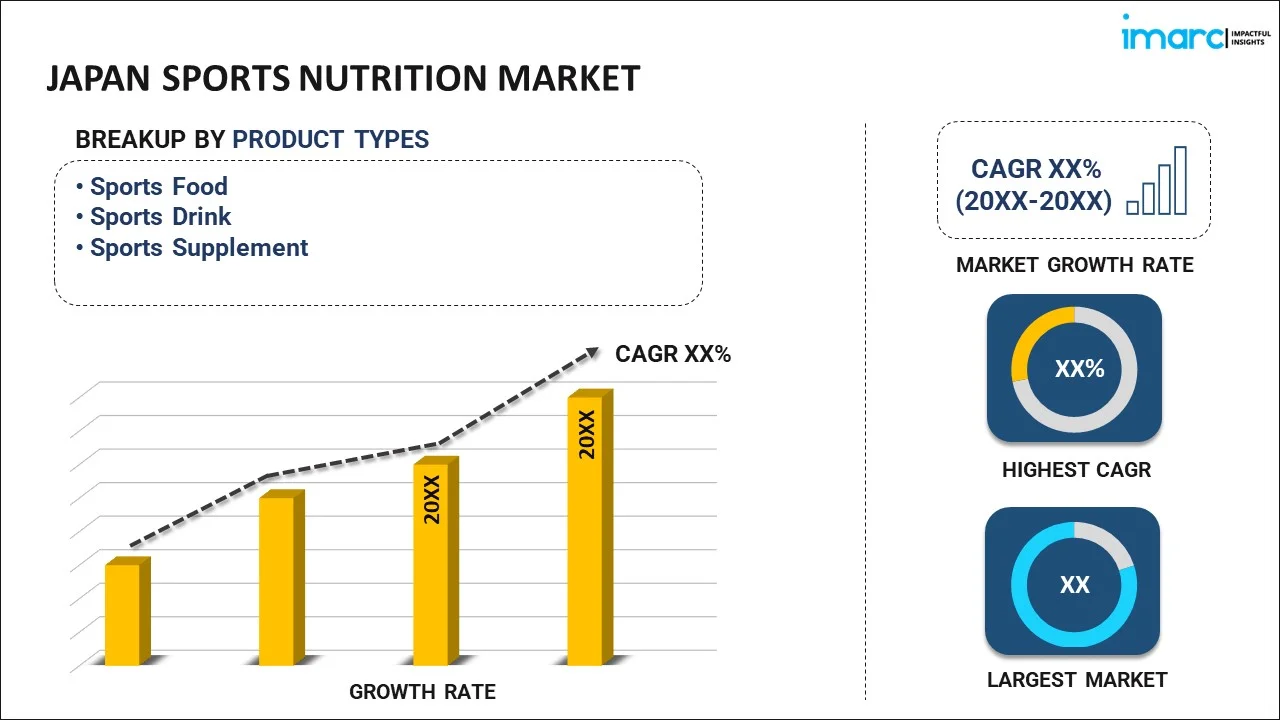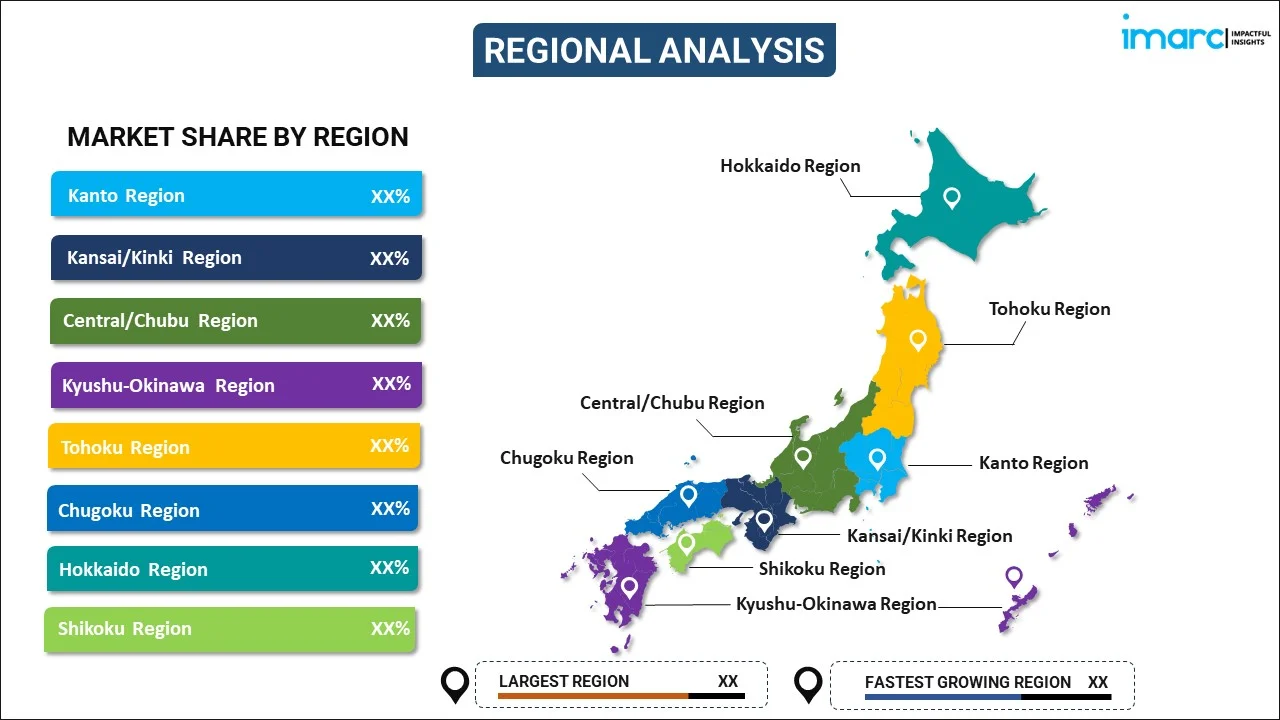
Japan Sports Nutrition Market Report by Product Type (Sports Food, Sports Drink, Sports Supplement), Origin (Animal-based, Plant-based), Distribution Channel (Supermarkets and Hypermarkets, Specialty Stores, Convenience Stores, Online Stores, Drug Stores and Pharmacies, and Others), and Region 2025-2033
Market Overview:
Japan sports nutrition market size reached USD 2.8 Billion in 2024. Looking forward, IMARC Group expects the market to reach USD 4.7 Billion by 2033, exhibiting a growth rate (CAGR) of 5.51% during 2025-2033. The market is experiencing growth due to several pivotal factors, including the growing embrace of healthier and more active lifestyles, heightened consumer recognition of the advantages associated with sports supplements, and the increasing proliferation of gyms and fitness centers.
|
Report Attribute
|
Key Statistics
|
|---|---|
|
Base Year
|
2024
|
|
Forecast Years
|
2025-2033
|
|
Historical Years
|
2019-2024
|
|
Market Size in 2024
|
USD 2.8 Billion |
|
Market Forecast in 2033
|
USD 4.7 Billion |
| Market Growth Rate 2025-2033 | 5.51% |
Sports nutrition refers to the practice of adhering to a nourishing diet and consuming nutrient-dense items to support the training objectives and routines of individuals engaged in physical activities. This category encompasses a diverse range of items, including sports drinks, isotonic beverages, protein supplements, dietary enhancements, and protein bars. These products are carefully formulated to cater to the heightened energy requirements of vigorous physical exertion and exercise, thereby enhancing performance and aiding in various fitness objectives, such as building lean muscle mass or enhancing body composition. Additionally, they contribute to the recovery process during and after sports activities like athletics, workouts, and bodybuilding. Furthermore, sports nutrition plays a role in mitigating the effects of physical fatigue and injuries while promoting overall health and well-being. These items are composed of a blend of macronutrients (such as carbohydrates, proteins, and fats), micronutrients (including vitamins and minerals), and other functional components like caffeine, creatine, and beta-alanine.
Japan Sports Nutrition Market Trends:
The Japan sports nutrition market is witnessing substantial growth, primarily driven by the surging popularity of fitness and sports activities, which has led to a heightened demand for a variety of sports nutrition products. This upsurge in demand is a key driver of market expansion. Additionally, the increasing incidence of lifestyle-related diseases like diabetes and obesity, attributed to sedentary lifestyles and unhealthy dietary habits, is creating a favorable environment for market growth. Furthermore, consumers' growing health consciousness and their desire to achieve fitness goals through sports nutrition products are significant contributors to market expansion. This trend is reinforced by the increasing awareness of the benefits associated with the consumption of such products. The adoption of functional foods, which offer additional health advantages beyond basic nutrition, is also driving demand for sports nutrition products with added functional benefits. The market is further propelled by ongoing product innovations, including the introduction of vegan, organic, and natural sports nutrition items. Factors such as the increasing preference for ready-to-drink (RTD) sports nutrition products, the proliferation of health clubs and gyms, and the widespread availability of e-commerce platforms facilitating easy checkout and doorstep delivery are expected to fuel the regional market over the forecasted period.
Japan Sports Nutrition Market Segmentation:
IMARC Group provides an analysis of the key trends in each segment of the market, along with forecasts at the country level for 2025-2033. Our report has categorized the market based on product type, origin, and distribution channel.
Product Type Insights:

- Sports Food
- Sports Drink
- Sports Supplement
The report has provided a detailed breakup and analysis of the market based on the product type. This includes sports food, sports drink, and sports supplement.
Origin Insights:
- Animal-based
- Plant-based
A detailed breakup and analysis of the market based on the origin have also been provided in the report. This includes animal-based and plant-based.
Distribution Channel Insights:
- Supermarkets and Hypermarkets
- Specialty Stores
- Convenience Stores
- Online Stores
- Drug Stores and Pharmacies
- Others
The report has provided a detailed breakup and analysis of the market based on the distribution channel. This includes supermarkets and hypermarkets, specialty stores, convenience stores, online stores, drug stores and pharmacies, and others.
Regional Insights:

- Kanto Region
- Kansai/Kinki Region
- Central/ Chubu Region
- Kyushu-Okinawa Region
- Tohoku Region
- Chugoku Region
- Hokkaido Region
- Shikoku Region
The report has also provided a comprehensive analysis of all the major regional markets, which include Kanto Region, Kansai/Kinki Region, Central/ Chubu Region, Kyushu-Okinawa Region, Tohoku Region, Chugoku Region, Hokkaido Region, and Shikoku Region.
Competitive Landscape:
The market research report has also provided a comprehensive analysis of the competitive landscape in the market. Competitive analysis such as market structure, key player positioning, top winning strategies, competitive dashboard, and company evaluation quadrant has been covered in the report. Also, detailed profiles of all major companies have been provided.
Japan Sports Nutrition Market Report Coverage:
| Report Features | Details |
|---|---|
| Base Year of the Analysis | 2024 |
| Historical Period | 2019-2024 |
| Forecast Period | 2025-2033 |
| Units | Billion USD |
| Scope of the Report | Exploration of Historical Trends and Market Outlook, Industry Catalysts and Challenges, Segment-Wise Historical and Future Market Assessment:
|
| Product Types Covered | Sports Food, Sports Drink, Sports Supplement |
| Origins Covered | Animal-based, Plant-based |
| Distribution Channels Covered | Supermarkets and Hypermarkets, Specialty Stores, Convenience Stores, Online Stores, Drug Stores and Pharmacies, Others |
| Regions Covered | Kanto Region, Kansai/Kinki Region, Central/ Chubu Region, Kyushu-Okinawa Region, Tohoku Region, Chugoku Region, Hokkaido Region, Shikoku Region |
| Customization Scope | 10% Free Customization |
| Post-Sale Analyst Support | 10-12 Weeks |
| Delivery Format | PDF and Excel through Email (We can also provide the editable version of the report in PPT/Word format on special request) |
Key Questions Answered in This Report:
- How has the Japan sports nutrition market performed so far and how will it perform in the coming years?
- What has been the impact of COVID-19 on the Japan sports nutrition market?
- What is the breakup of the Japan sports nutrition market on the basis of product type?
- What is the breakup of the Japan sports nutrition market on the basis of origin?
- What is the breakup of the Japan sports nutrition market on the basis of distribution channel?
- What are the various stages in the value chain of the Japan sports nutrition market?
- What are the key driving factors and challenges in the Japan sports nutrition?
- What is the structure of the Japan sports nutrition market and who are the key players?
- What is the degree of competition in the Japan sports nutrition market?
Key Benefits for Stakeholders:
- IMARC’s industry report offers a comprehensive quantitative analysis of various market segments, historical and current market trends, market forecasts, and dynamics of the Japan sports nutrition market from 2019-2033.
- The research report provides the latest information on the market drivers, challenges, and opportunities in the Japan sports nutrition market.
- Porter's five forces analysis assist stakeholders in assessing the impact of new entrants, competitive rivalry, supplier power, buyer power, and the threat of substitution. It helps stakeholders to analyze the level of competition within the Japan sports nutrition industry and its attractiveness.
- Competitive landscape allows stakeholders to understand their competitive environment and provides an insight into the current positions of key players in the market.
Need more help?
- Speak to our experienced analysts for insights on the current market scenarios.
- Include additional segments and countries to customize the report as per your requirement.
- Gain an unparalleled competitive advantage in your domain by understanding how to utilize the report and positively impacting your operations and revenue.
- For further assistance, please connect with our analysts.
 Inquire Before Buying
Inquire Before Buying
 Speak to an Analyst
Speak to an Analyst
 Request Brochure
Request Brochure
 Request Customization
Request Customization




.webp)




.webp)












